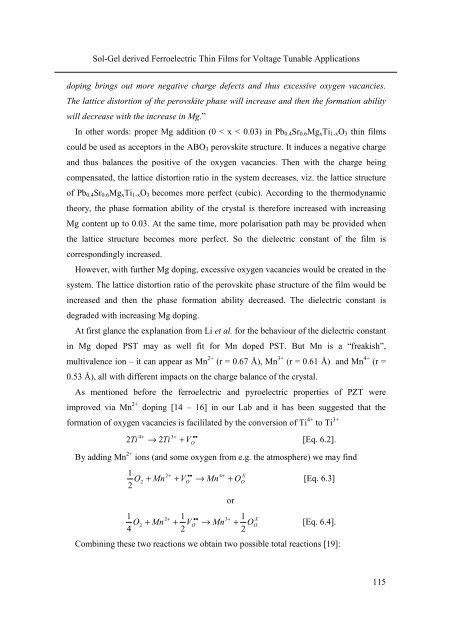PhD Thesis Arne Lüker final version V4 - Cranfield University
PhD Thesis Arne Lüker final version V4 - Cranfield University
PhD Thesis Arne Lüker final version V4 - Cranfield University
Create successful ePaper yourself
Turn your PDF publications into a flip-book with our unique Google optimized e-Paper software.
Sol-Gel derived Ferroelectric Thin Films for Voltage Tunable Applications<br />
doping brings out more negative charge defects and thus excessive oxygen vacancies.<br />
The lattice distortion of the perovskite phase will increase and then the formation ability<br />
will decrease with the increase in Mg.”<br />
In other words: proper Mg addition (0 < x < 0.03) in Pb0.4Sr0.6MgxTi1-xO3 thin films<br />
could be used as acceptors in the ABO3 perovskite structure. It induces a negative charge<br />
and thus balances the positive of the oxygen vacancies. Then with the charge being<br />
compensated, the lattice distortion ratio in the system decreases, viz. the lattice structure<br />
of Pb0.4Sr0.6MgxTi1-xO3 becomes more perfect (cubic). According to the thermodynamic<br />
theory, the phase formation ability of the crystal is therefore increased with increasing<br />
Mg content up to 0.03. At the same time, more polarisation path may be provided when<br />
the lattice structure becomes more perfect. So the dielectric constant of the film is<br />
correspondingly increased.<br />
However, with further Mg doping, excessive oxygen vacancies would be created in the<br />
system. The lattice distortion ratio of the perovskite phase structure of the film would be<br />
increased and then the phase formation ability decreased. The dielectric constant is<br />
degraded with increasing Mg doping.<br />
At first glance the explanation from Li et al. for the behaviour of the dielectric constant<br />
in Mg doped PST may as well fit for Mn doped PST. But Mn is a “freakish”,<br />
multivalence ion – it can appear as Mn 2+ (r = 0.67 Å), Mn 3+ (r = 0.61 Å) and Mn 4+ (r =<br />
0.53 Å), all with different impacts on the charge balance of the crystal.<br />
As mentioned before the ferroelectric and pyroelectric properties of PZT were<br />
improved via Mn 2+ doping [14 – 16] in our Lab and it has been suggested that the<br />
formation of oxygen vacancies is facililated by the con<strong>version</strong> of Ti 4+ to Ti 3+<br />
Ti 2 [Eq. 6.2].<br />
+<br />
+ ••<br />
→ + O V Ti<br />
4<br />
3<br />
2<br />
By adding Mn 2+ ions (and some oxygen from e.g. the atmosphere) we may find<br />
1<br />
2+<br />
••<br />
4+<br />
O 2 + Mn + VO<br />
→ Mn + O<br />
2<br />
1 2+<br />
1 ••<br />
3+<br />
O2<br />
+ Mn + VO<br />
→ Mn<br />
4<br />
2<br />
or<br />
X<br />
O<br />
1<br />
+ O<br />
2<br />
X<br />
O<br />
[Eq. 6.3]<br />
[Eq. 6.4].<br />
Combining these two reactions we obtain two possible total reactions [19]:<br />
115

















